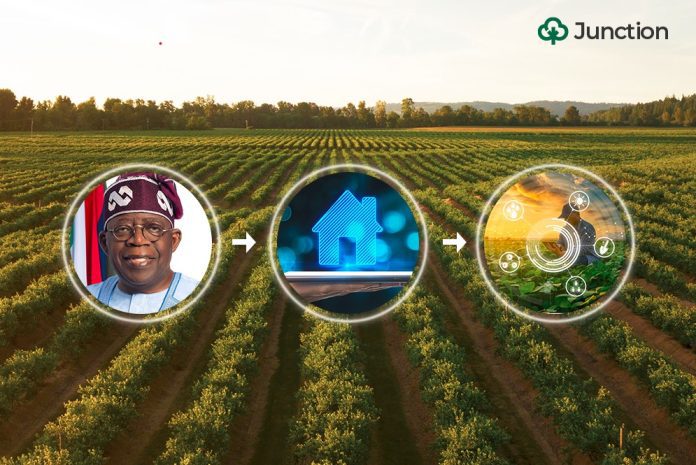Questions answered here: - How can we improve the way agriculture finance interventions typically work in Nigeria? - What role should Nigeria's agricultural credit risk guarantee entity play in encouraging more retail investors to bet on the sector? - How can local and foreign investors work with commercial and developmental finance entities to build wealth in agriculture?
Countries typically use development finance institutions (DFIs) to support economic development in form of interventions, and Nigeria is no different. Left to its own whims, agriculture in Nigeria struggles to attract investors and lags behind several sectors including manufacturing, services and others.
Thus, there is a need for government-led agricultural finance interventions. Although, alone, it is not enough to get Nigeria’s agriculture to the levels where it matches its potentials. The country’s effort in funding agriculture using development finance accounts form a significant percentage of the sector’s total financing so far. One example is the about ₦1.07 trillion that the Central Bank of Nigeria (CBN) allocated and disbursed to farmers between 2015 and 2023.
While we (The Junction) had previously explored a new way to approach financing through rousing support from private and public sectors, both local and international, this article looks at turning existing government agriculture finance interventions into effective support for more parties involved in the agriculture value chain. You will see why intervention funding may be more impactful than it currently is. It will also reveal opportunities for creating more deeply capitalised ventures that improves agriculture and the economy.
How agriculture development interventions work in Nigeria and what should change
Public sector led agriculture finance interventions typically flows directly from government agencies to last mile users or recipients-through banks as disbursement channels, leaving opportunities for adjacent value such as value chain strengthening, and new venture development on the table.
If old and new ventures handle elements of these funds allocation, disbursements and assurance, they can support proper utilisation and enhance their impact. Thus, it will improve the funds’ results and venture’s value, ultimately positioning the supporting ventures to access capital and grow to do more in agriculture, even outside agricultural finance interventions.
Chart 1:

For example, an agricultural intervention programme that disburses ₦1.07 trillion to 4.6 million participants can potentially create about five 1-billion-dollar valued ventures as we will see in the rest of this article. These ventures can be spread across areas like identification, education and extension, last mile financial services, resource management, monitoring and evaluation, marketplace, and commodity trading and facilitation.
As the 4.6 million participants and ₦1.07 trillion flow through these interlinked ventures that deliver critical implementation capacity and value to the programme, the ventures improve the programme’s chances for success and effectiveness, and by extension, retain and grow the participants as customers in their businesses. Thus, creating a path to sustainability for these ventures and their interaction with beneficiaries, even outside of the interventions.
Chart 2:

Beyond the ventures that provide implementation capacity, thousands of service providers in areas like storage, irrigation and mechanisation can also reach million-dollar venture values, if they derive catalytic source of business from agricultural finance interventions. This will opening them to additional capital to operate, support agriculture, and grow outside of the interventions.
Therefore, there is good sense in advocating for the deliberate addition of venture and value building of enterprises that support the delivery of agricultural interventions to Key Performance Indices (KPI) of such interventions. Unfortunately, these are missed opportunities in the past.
Agriculture development interventions could be a place for retail investors
Retail-investor financing of agriculture gained popularity and traction in Nigeria between 2015 and 2020, as was evidenced in establishment of startups like Farm Crowdy and others. However, a downturn occasioned by losses and Covid-19 set in, and most of these enterprises did not survive, while the few that did pivoted their models. Yet, based on the patronage and rapid activity rate in their short life span, it is clear that retail investors will put their money into agriculture. Nigeria Incentive-Based Risk Sharing System For Agricultural Lending (NIRSAL Plc.) is opportune to step in to restore trust and activity by instituting guarantees that covers retail investors for an opportunity to deepen access to funding, especially with diaspora investments.
NIRSAL and financial services providers in agriculture should note the opportunity to aggregate funds from retail investing public for short-term working capital, while they free institutional funds for strategic long-term capital expenditure that finances a solid foundation for long-term, year-round production. If done properly, an agricultural Credit Risk Guarantee (CRG) type mechanism that is targeted at managing retail investors, can aggregate funds from the investing public for short-term working capital expenditure financing to agriculturists.
For example, cooperatives and agricultural partnerships’ short-term capital targeted at such term working capital requirements such as input and services can free commercial credit funds for long-term strategic investments such as land clearing, irrigation, mechanisation and processing. The current situation where most institutional, retail and development financing for agriculture congregates to pursue short-term working capital financing does not resolve Nigeria’s underperformance in agriculture, as they lack a strategic outlook for fixing the major foundational problems of large-scale irrigation, mechanisation, logistics and processing.
If an agricultural CRG framework, as provided by Nigeria Incentive-Based Risk Sharing System for Agricultural Lending, collaborates with retail investment platforms, it will further boost the investing public’s confidence and improve funding for productivity and returns. It can also unlock more bank and non-bank private sector funding for agriculture.
In the model, NIRSAL Plc guarantees retail investor risks per its mandate. It structures them for access to irrigable land for year-round farming, logistics and processing, while the platforms fund working capital for input and services.
Table 1:

This model also presents the opportunity to unlock additional capital from medium to large staff cooperatives of both private and public sector organisations in Nigeria. These cooperatives hold significant assets under management (AUM), and often, they look for investment opportunities with reasonable interest, low risk and social impacts that can benefit their members.
Facilitating this collaboration requires frameworks such as the existing outgrower model (where buyer agrees to make purchase before crops are ready and provide support to farmers). Additionally, they can consider new concepts such as incorporating NIRSAL-approved land managers, processors, and logistics service providers who will receive funding to oversee and handle aspects such as irrigated land, mechanisation, logistics, processing, and farm infrastructure within specific hubs. These services will be offered to farmers organised and managed by NIRSAL-approved outgrower systems.
Table 2:

Complimentary debt and equity for big results
Intentionally placing and sweating every Naira injection for cashflow, capital appreciation, profit, and tax benefits can unlock significant financing for Nigeria’s agricultural transformation.
Nigeria’s agricultural financing outlook should innovatively merge debt and equity financing principles available in the market. This approach would create a value creation and enhancement loop that uses the same effort and funds to increase the availability of commercial lending through expanded CRG. It could also grow the CRG fund with returns on venture investments, and increase venture portfolio value by ensuring a source of business for venture companies through the patronage of entities supported by its guaranteed lending.

Optimising existing assets for multidimensional value
There is an opportunity to unlock significant value and growth for CRG and Venture funding from existing market-facing and federal government-owned agricultural assets if transferred to a holding company for venture development and capital appreciation.
Nigeria, through its Ministries, Departments & Agencies (MDAs), holds a significant shareholding in commercial and developmental agricultural business entities. Some of these are the River Basin Development Authorities (RBDAs), and Nigeria Commodity Exchange. If local and foreign investors participate within these entities, they can enhance and capitalise them. They hold tremendous potential to generate funds.
Going by the high valuations that Nigerian startups, especially in financial services, trade, and skills development have reached, if adequately implemented, this effort can attract up to $5 billion from existing entities, and can aggregate up to US$20 billion in five years through investing activities in ventures that will support interventions for Nigeria’s agricultural transformation.
Compared to direct disbursement of agriculture finance interventions that terminates directly with the recipients, the proposed model creates an opportunity to stretch and revolve every “Naira” investment using a firm framework that supports a system of continuous investments in a large and growing number of ventures. In the same vein, it provides debt and equity financing, sound agricultural ventures, and dependable sources of business to these ventures for sustainability and profitability. All of which are catalysed in a loop of related activities.
Table 3:

Revisit Cash Reserve Ratio
On achieving ample CRG pool, CBN can rebase Cash Reserve Ratio (CRR) sterilisation, especially of the portion that is over regulatory limit, to free up cash for land clearing, irrigation, and their adjoining ventures of mechanisation, logistics and processing, to support integrated farm to market development.
Rebasing CRR to release the portion over the regulatory limit has the potential to release about $5 billion cash. These monies can be madeavailable for financing ventures in agricultural hubs. Since the CRR is often times used to fight inflation, releasing and purposing the portion that is over the regulatory limit into food production and supporting ventures will ultimately improve food supply and drive down food prices, which is a large contributor to Nigeria’s inflation.
In considering and implementing this, the CBN must put a strong mechanism in place to ensure that the released cash is strictly utilised to develop the country’s agriculture, food, and export capacity, with attendant benefits such as job creation and agricultural export-driven foreign currency earning. It will also undertake the necessary impact assessment and evaluation down the value chain on objectives such as financing agriculture and its impact on food prices driven inflation, respectively.
NIRSAL Plc, through its existing mandate, already possesses the tools and capacity to issue credit guarantees for the credit from the freed-up cash. It can use it to offer technical support and value chain development to ensure optimal development of land clearing, irrigation, mechanisation, logistics and processing. The adjoining ventures are to be integrated profitably to create an integrated local supply and export capacity development for agriculture.
Agricultural resurgence led by new thinking
As the agricultural partnerships and funding platforms’ ability to raise funds and the investing public’s confidence demonstrates, there is good interest in agricultural investments. Estimates show that up to $11 billion can be unlocked in revolving investment in agriculture from the local and diaspora investing public alone by 2030. If banks and institutional local and foreign investors join in, this value can go up to $20 billion in the same period. This will be a much-needed complement to the CBN’s and other intervention efforts, and it will take agricultural investments to sustainable levels outside the Government’s direct intervention.
Financial institution credit to agriculture will also grow from about 3.36% of total credit to the private sector to about 25%. This will be the perfect picture of the success of a Dangote refinery-like intervention of public and private sector financing support in catalysing agricultural development in Nigeria.
There is no better time than now to make a lasting dent in the interdependent issues of food security and unemployment challenges with deliberate effort to improve Nigeria’s agricultural productivity through adequate financing. Adequate financing of the mix of young people’s participation, technology, and irrigable mechanised land in a service model, and in hubs that add value through processing and attendant logistics, creates opportunities for exponential leaps in agriculture that will leave a legacy that will last for decades.
Nigeria needs a new inclusive model for financing its agriculture, one which includes more players, that will support land, irrigation, mechanisation, logistics and processing, which also creates access for young people. The model must attract investment and funding from the private sector to support the public sector investment effort. This way, it provides an opportunity to improve how things are done in the country’s agriculture for the better, and optimise it for local and global gains.




Thoughtful.